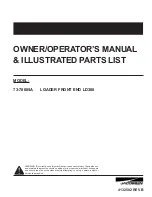
50950106/AP0313
49
Cold Start Aids
At an ambient temperature of 32° F (0° C) or below, no starting aids are
required. However, as with any diesel vehicle, using the recommended
engine oil, maintaining a healthy battery and installing an engine block
heater are sound practices to improve cold-starting performance and
prolonging starter life.
At an ambient temperature of 14° F (-10° C) or below, a healthy battery
is essential as glow cycles and cranking cycles can induce a substantial
load on the battery during start. An engine block heater is recommended
at this temperature to reduce starter load and improve the engine warm-
up period prior to loader operation. Attempting to start the loader
without a block heater will result in multiple glow/crank cycles or pos-
sible extended cranking time approaching 20 seconds.
At an ambient temperature of 5° F (-15° C) or below, a healthy battery is
imperative. A recommended battery charger/maintainer applied before
or during a start cycle will help maintain 12 V to the starter circuit
during a potential long crank cycle of 20 seconds or more. A required
block heater will reduce starter load, reduce crank time and improve the
overall engine warm-up time during extreme cold starts.
Speed Limit Protection During A Cold Start
Depending upon coolant temperature, 14° F (-10° C) or below, the max-
imum engine speed allowable is 1500 rpm. This 1500 rpm limit remains
in effect for approximately 10 seconds or less. If a throttle command
above 1500 rpm is requested during this 10 second time frame, the oper-
ator must return the throttle to a command less than 1500 rpm before
returning to a desired throttle position above 1500 rpm.
Stopping the Loader
The following procedure is the recommended sequence for stopping the loader:
1. Check that the drive control handle(s) is (are) in neutral position.
2. Lower the lift arm and rest the attachment on the ground.
3. Turn throttle knob back to the low idle position (and release the throttle pedal
for joystick and T-bar control machines). Allow the engine to idle for five
minutes if the engine was operated under full load.
4. Turn the keyswitch to the OFF position and remove the key.
5. Move the lift/tilt control to verify that the safety interlock system is prevent-
ing movement.
6. Raise the restraint bar, unfasten the seatbelt(s) and grasp the handholds while
climbing out of the operator’s compartment.
Note:
The skid-steer loader is equipped with a spring-applied automatic parking
brake. The parking brake is applied when the operator lifts the restraint bar,
leaves the operator’s seat or shuts off the engine, or actuates the parking brake
switch.
Summary of Contents for R190
Page 1: ...Skid Steer Loaders Operator s Manual Form No 50950106 AP0313 English R190 R220 R260 ...
Page 4: ......
Page 22: ...18 50950106 AP0313 Notes ...
Page 36: ...32 50950106 AP0313 Information Center Electronic Display cont ...
Page 37: ...50950106 AP0313 33 Information Center Electronic Display cont ...
Page 50: ...46 50950106 AP0313 Notes ...
Page 86: ...82 50950106 AP0313 Engine Diagnostic Chart ...
Page 87: ...50950106 AP0313 83 Engine Diagnostic Chart cont ...
Page 88: ...84 50950106 AP0313 Engine Diagnostic Chart cont ...
Page 89: ...50950106 AP0313 85 Engine Diagnostic Chart cont ...
Page 90: ...86 50950106 AP0313 Engine Diagnostic Chart cont ...
Page 108: ...104 50950106 AP0313 Maintenance Log Date Hours Service Procedure ...
Page 109: ...50950106 AP0313 105 Maintenance Log Date Hours Service Procedure ...
Page 110: ...106 50950106 AP0313 Maintenance Log Date Hours Service Procedure ...
Page 122: ...118 50950106 AP0313 Notes ...





































